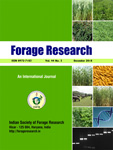PREETY RANI, SARITA DEVI*, SATPAL, SUKHAM MADAAN, PANKAJ AND GAYATRI
Department of Botany & Plant Physiology, CCSHAU, Hisar -125004 (Haryana), India
Department of G&PB (Forage Section), CCSHAU, Hisar -125004 (Haryana), India
*(e-mail: devisaritaa@gmail.com)
(Received : 07 March 2025; Accepted 27 March 2025)
SUMMARY
Agricultural biostimulants include diverse formulations of compounds, substances and
micro-organisms which applied to plants or soils to improve crop vigour, yields, quality and tolerance
of abiotic stresses. The investigation was carried out for the assessment of Physiological responses
of various bio-stimulants in Vigna unguiculata L. genotype (CS-88) under rainfed condition during
the summer season of 2019. The investigation conducted at Dryland Research Farm, Forage Section
under rainfed conditions at CCS HAU, Hisar. Bio-stimulants were applied exogenously at flower
initiation stage. The physiological parameters in cowpea plant like water relation, gaseous exchange
studies chlorophyll content (SPAD units) and photochemical quantum yield showed declining trend
in rainfed condition. But with the imposition of different bio-stimulants at flower initiation stage,
values of physiological parameters found to be increased. Values ranged from control to biostimulant
application in osmotic potential (-MPa) (-1.24 to -1.09), RWC (%) (72.7 – 88.7). Similarly, chlorophyll
content (SPAD units) and photochemical quantum yield also showed the increasing trend after foliar
application of different biostimulants and the values varied from (41.0 – 51.4) and (0.678 – 0.718),
respectively. Reversibly, relative stress injury was found to be decreased from control (35.51) to
biostimulants application (20.58) in cowpea under moisture stress. The value of biochemical
parameters ranges from proline (131.4 – 381.9 µg g-1 DW) and glycine betaine (144.0 – 424.2 µmol g-1
DW) over their respective control. Conclusively, based on the above studies it could be concluded
that after foliar spray of different biostimulants under rainfed condition, cowpea performed better by
maintaining higher plant water status, photosynthetic rate and lower values of RSI (%). Biostimulants
treatments not only ameliorate the effect of moisture stress on plants, but also showed a stimulating
effect. Application of 2 % complex N, P, K was found more effective which was at par with SA 100
ppm spray at flower initiation than others biostimulants in cowpea.
Key words: Biostimulants, cowpea, Glycine betaine, Proline content and RWC

